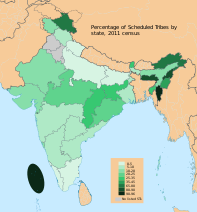
Back অনুসূচীত জাতি আৰু অনুসূচীত জনজাতি Assamese Hindistan tayfaları Azerbaijani अनुसूचित जाति अउरी अनुसूचित जनजाति Bihari তফসিলি জাতি ও তফসিলি জনজাতি Bengali/Bangla Castes i tribus reconegudes Catalan Castas registradas y tribus registradas Spanish Registreeritud kastid ja hõimud Estonian अनुसूचित जाति और अनुसूचित जनजाति Hindi Tribù e caste riconosciute dall'India Italian 指定カーストと指定部族 Japanese
This article is missing information about Scheduled Tribes. (November 2023) |
The Scheduled Castes[1] and Scheduled Tribes (abbreviated as SCs and STs) are officially designated groups of people and among the most disadvantaged socio-economic groups in India.[2] The terms are recognized in the Constitution of India and the groups are designated in one or other of the categories.[3]: 3 For much of the period of British rule in the Indian subcontinent, they were known as the Depressed Classes.[3]: 2
In modern literature, many castes under the Scheduled Castes category are sometimes referred to as Dalit, meaning "broken" or "dispersed" for the untouchables.[5][6] The term having been popularised by the Dalit leader B. R. Ambedkar during the independence struggle.[5] Ambedkar preferred the term Dalit over Gandhi's term Harijan, meaning "people of Hari" (lit. 'Man of God').[5] Similarly, the Scheduled Tribes are often referred to as Adivasi (earliest inhabitants), Vanvasi (inhabitants of forest) and Vanyajati (people of forest). However, the Government of India refrains from using such derogatory and incorrect terms that carry controversial connotations. For example, 'Dalit', which literally means 'oppressed', has been historically associated with notions of uncleanness, carries implications of reinforcing the concept of untouchability. Similarly, 'Adivasi', which means 'original inhabitants', carries implications of native and immigrant distinctions and also perpetuates the stereotypes of being civilized and uncivilized.[7] Therefore, the Constitutionally recognized inclusive terms "Scheduled Castes" (Anusuchit Jati) and "Scheduled Tribes" (Anusuchit Janjati) are preferred in official usage, as these designated terms are intended to address socio-economic disabilities, rather than to reimpose those social stigmas and issues.[8][9] In September 2018, the government "issued an advisory to all private satellite channels asking them to refrain from using the derogatory nomenclature 'Dalit', though rights groups and intellectuals have come out against any shift from 'Dalit' in popular usage".[10]
The Scheduled Castes and Scheduled Tribes comprise about 16.6% and 8.6%, respectively, of India's population (according to the 2011 census).[11][12] The Constitution (Scheduled Castes) Order, 1950 lists 1,108 castes across 28 states in its First Schedule,[13] and the Constitution (Scheduled Tribes) Order, 1950 lists 744 tribes across 22 states in its First Schedule.[14]
Since the independence of India, the Scheduled Castes and Scheduled Tribes were given Reservation status, guaranteeing political representation, preference in promotion, quota in universities, free and stipended education, scholarships, banking services, various government schemes and the Constitution lays down the general principles of positive discrimination for SCs and STs.[15][16]: 35, 137
- ^ "Scheduled Caste Welfare – List of Scheduled Castes". Ministry of Social Justice and Empowerment. Archived from the original on 13 September 2012. Retrieved 16 August 2012.
- ^ "Scheduled Castes And Scheduled Tribes". United Nations in India. Archived from the original on 22 November 2021. Retrieved 21 November 2021.
- ^ a b Cite error: The named reference
scheduledcommunitieswas invoked but never defined (see the help page). - ^ a b c d "Census of India 2011, Primary Census Abstract (28 October 2013)" (ppt). Scheduled Castes and Scheduled Tribes, Office of the Registrar General & Census Commissioner, Government of India. 23 September 2015. Archived from the original on 23 September 2015.
- ^ a b c Roychowdhury, Adrija (5 September 2018). "Why Dalits want to hold on to Dalit, not Harijan, not SC". The Indian Express. Archived from the original on 29 November 2021. Retrieved 29 November 2021.
- ^ "Dalit". Merriam-Webster.com Dictionary. Archived from the original on 6 October 2022. Retrieved 6 October 2022.
- ^ Ghurye, G. S. (1980). The Scheduled Tribes of India (3rd ed.). Transaction Publishers. ISBN 978-0-87855-692-2.
- ^ Bali, Surya (26 October 2018). "We are 'Scheduled Tribes', not 'Adivasis'". Forward Press. Retrieved 5 December 2023.
- ^ Dasgupta, Sangeeta (October 2018). "Adivasi studies: From a historian's perspective". History Compass. 16 (10). doi:10.1111/hic3.12486. ISSN 1478-0542.
- ^ Union minister: Stick to SC, avoid the term 'Dalit' Archived 22 October 2018 at the Wayback Machine "Union social justice minister Thawarchand Gehlot said media should stick to the constitutional term "Scheduled Castes" while referring to Dalits as there are objections to the term to the term "Dalit" – backing the government order which has significant sections of scheduled caste civil society up in arms." Times of India 5 September 2018.
- ^ "2011 Census Primary Census Abstract" (PDF). Censusindia.gov.in. Archived (PDF) from the original on 5 August 2020. Retrieved 1 October 2017.
- ^ "Half of India's dalit population lives in 4 states". The Times of India. 2 May 2013. Archived from the original on 11 November 2020. Retrieved 1 October 2017.
- ^ "Text of the Constitution (Scheduled Castes) Order, 1950, as amended". Lawmin.nic.in. Archived from the original on 19 June 2009. Retrieved 1 October 2017.
- ^ "Text of the Constitution (Scheduled Tribes) Order, 1950, as amended". Lawmin.nic.in. Archived from the original on 20 September 2017. Retrieved 1 October 2017.
- ^ Kumar, K Shiva (17 February 2020). "Reserved uncertainty or deserved certainty? Reservation debate back in Mysuru". The New Indian Express. Archived from the original on 21 November 2021. Retrieved 29 November 2021.
- ^ "THE CONSTITUTION OF INDIA [As on 9th December, 2020]" (PDF). Legislative Department. Archived (PDF) from the original on 26 November 2021. Retrieved 29 November 2021.

